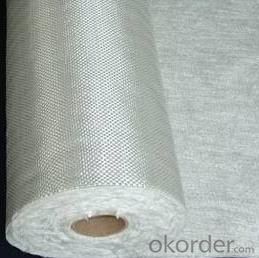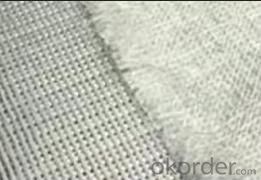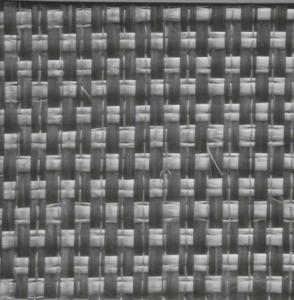FIBERGLASS WOVEN ROVING COMNO MAT
OKorder Service Pledge
OKorder Financial Service
You Might Also Like
Structure of woven roving combo mat Description:
Fiberglass stitch combo mat is the mat combining the woven roving and a even layer of chopped strand mat with polyester yarn.
Main Features of the woven roving combo mat
• Fiber level unfolded without cross, high density, high utilizing rate.
• Multi-layer finished one time, decrease layer and enhance efficiency.
• Providing the product with multi-directional mechanical strength.
Woven roving combo mat Images


Woven roving combo mat Specification:
| ||||||||||||||||||||||||||||||||||||||||||||||||||||
FAQ of Woven roving combo mat:
Mainly be used as reinforced materials in the composite material industry.
• Matrix: unsaturated polyester resin, vinyl ester resin, epoxy resin and phenolic resin etc.
• Craft: pultrusion, RTM, hand lay up, etc.
• Ultimate products: pultruded profiles, FRP body of boat, insulation board, automobile body.
Delivery Detail: 15-21days
Other spec. can be custom made as per customer's request.
- Q:Is fiberglass mat tissue fire resistant?
- Yes, fiberglass mat tissue is fire resistant. Fiberglass is made from a combination of glass fibers and resin, which gives it excellent fire-resistant properties. It has a high melting point and does not easily ignite or support combustion. Additionally, fiberglass mat tissue is often treated with fire-resistant coatings or additives to further enhance its fire-resistant capabilities. This makes fiberglass mat tissue a popular choice for various applications where fire resistance is required, such as insulation materials, protective clothing, and fireproof barriers.
- Q:How does fiberglass mat tissue compare to spray foam insulation?
- Fiberglass mat tissue and spray foam insulation are two different types of insulation materials with their own unique characteristics and benefits. Fiberglass mat tissue is a type of insulation made from woven strands of fiberglass. It is typically used in applications where thermal insulation is required, such as in walls, roofs, and attics. Fiberglass mat tissue is known for its high resistance to heat transfer, making it an effective insulator. It is also fire-resistant, which adds an additional safety benefit. On the other hand, spray foam insulation is a type of insulation that is applied as a liquid and expands into a solid foam. It can fill in small cracks and gaps, creating an airtight seal, which makes it an excellent choice for preventing air leakage and reducing energy loss. Spray foam insulation is also known for its excellent soundproofing qualities. In terms of installation, fiberglass mat tissue usually comes in large rolls or batts that need to be cut and fitted into place. It requires careful handling to ensure proper installation and may require the use of protective equipment, such as gloves and masks, as the fibers can cause skin and respiratory irritation. Spray foam insulation, on the other hand, is applied using specialized equipment that sprays the liquid foam onto the desired surface. It expands quickly, filling in any gaps or voids, and hardens within a short period of time. This makes it a more convenient option for insulating hard-to-reach areas or irregularly shaped spaces. When comparing the two, fiberglass mat tissue is generally more cost-effective, as it is less expensive to purchase and install compared to spray foam insulation. However, spray foam insulation provides better air sealing and can offer higher energy savings in the long run. In summary, fiberglass mat tissue and spray foam insulation have their own advantages and are suited for different insulation needs. Fiberglass mat tissue is a good option for thermal insulation, while spray foam insulation excels in air sealing and soundproofing. The choice between the two ultimately depends on factors such as budget, desired insulation performance, and the specific requirements of the project.
- Q:Can fiberglass mat tissue be used for insulation in commercial buildings?
- Insulation in commercial buildings can be achieved using fiberglass mat tissue. This material is commonly utilized due to its exceptional thermal performance, durability, and cost-effectiveness. Typically composed of fine glass fibers bonded with resin, the mat can be applied to various surfaces such as walls and ceilings to enhance energy efficiency by minimizing heat transfer. Proper insulation is vital in commercial buildings to maintain a comfortable indoor environment and reduce energy usage. Fiberglass mat tissue offers numerous benefits for insulation purposes. It possesses low thermal conductivity, effectively resisting heat flow and diminishing heat loss or gain through the building envelope. This results in lower energy expenses and improved temperature control. Furthermore, fiberglass mat tissue is lightweight and easy to install, making it a convenient option for commercial buildings. It can be easily cut and shaped to fit around obstacles, ensuring a secure seal and preventing air leakage. This further enhances the effectiveness of the insulation. Moreover, fiberglass mat tissue is non-combustible, providing an added safety advantage in commercial buildings where fire protection is paramount. It does not contribute to the spread of flames and its fire resistance properties assist in containing fires and offering valuable escape time during emergencies. Overall, fiberglass mat tissue is a suitable and widely utilized insulation material in commercial buildings. Its thermal performance, ease of installation, and fire resistance make it a dependable choice for achieving energy efficiency and comfort in commercial spaces.
- Q:Does fiberglass mat tissue provide good thermal conductivity?
- Fiberglass mat tissue, unfortunately, does not possess commendable thermal conductivity. The insulating properties of fiberglass are widely recognized, as it serves as an inadequate conductor of heat. Its thermal conductivity is low, resulting in ineffective heat transfer. As a consequence, fiberglass mat tissue is an appropriate choice for insulation purposes, particularly in scenarios where minimizing heat transfer is essential, like in building insulation or the production of heat-resistant garments.
- Q:What are the main applications of fiberglass mat tissue?
- Fiberglass mat tissue, an adaptable material, finds diverse applications in industries like construction, automotive, aerospace, and marine. Key uses of this material comprise: 1. Construction: Fiberglass mat tissue commonly reinforces and strengthens building materials in the construction industry, including roofing shingles, wallboards, and cementitious products. It enhances tensile strength and durability, rendering the structures more resistant to cracks, water damage, and weathering. 2. Automotive: The manufacturing of automotive parts, such as dashboards, door panels, and trunk liners, heavily relies on fiberglass mat tissue. It imparts structural integrity, sound insulation, and heat resistance, contributing to safer and more comfortable vehicles. 3. Aerospace: Lightweight composite materials used in aircraft structures benefit from the inclusion of fiberglass mat tissue. This material aids in reducing overall weight, improving fuel efficiency, and enhancing performance. 4. Marine: Fiberglass mat tissue plays a significant role in boat and shipbuilding. It provides strength, stiffness, and resistance to water and corrosion in the construction of hulls, decks, and other components. Its lightweight, durability, and low maintenance requirements make it preferable to traditional materials like wood. 5. Electrical and Electronics: Fiberglass mat tissue serves electrical insulation purposes, such as transformer boards, electrical cabinets, and switchgear. Its excellent dielectric properties, heat resistance, and mechanical strength ensure the safety and reliability of electrical equipment. 6. Filtration: Various filtration applications, such as air filters, water filters, and oil filters, employ fiberglass mat tissue. It acts as a filtration medium, capturing and eliminating impurities, dust, and particles from air, water, or oil, thereby enhancing the quality and purity of filtered substances. In summary, fiberglass mat tissue finds extensive use across industries due to its strength, durability, lightweight nature, and resistance to environmental factors. Its versatility enables it to be an indispensable component in diverse applications, contributing to the development of safer, sturdier, and more efficient products.
- Q:Can fiberglass mat tissue be used for reinforcing concrete structures?
- Indeed, fiberglass mat tissue can be utilized to fortify concrete structures. This material, crafted from woven glass fibers, is thin and lightweight. It boasts a commendable strength-to-weight ratio and exceptional resistance to corrosion, rendering it an optimal selection for reinforcing concrete structures. When employed as reinforcement in concrete, fiberglass mat tissue is typically embedded within the concrete mixture. This inclusion aids in enhancing the concrete's tensile strength and ductility, effectively preventing cracks and augmenting its overall durability. Fiberglass mat tissue is frequently employed in various applications, including precast concrete panels, concrete pipes, and concrete overlays. These structures benefit from the reinforcement provided by fiberglass mat tissue, enabling them to endure heavy loads and resist cracking, particularly in areas where concrete alone may prove inadequate. Additionally, fiberglass mat tissue exhibits resistance to chemicals and environmental elements, qualifying it for use in harsh conditions or exposed surroundings. It does not succumb to corrosion or rust like traditional steel reinforcements, ensuring the longevity and structural integrity of the concrete structure. In conclusion, fiberglass mat tissue stands as a dependable and efficient choice for reinforcing concrete structures. Its lightweight nature, impressive strength, corrosion resistance, and durability have solidified its status as a popular option within the construction industry.
- Q:Can fiberglass mat tissue be used for making boat hulls?
- Fiberglass mat tissue is indeed suitable for the construction of boat hulls. This lightweight and robust material is widely employed in the boat-building and repairing industry. By combining fiberglass strands with a binder, a flexible mat is formed, allowing for easy shaping and molding into various forms. Boat hulls necessitate a sturdy, water-resistant material with excellent structural integrity, all of which fiberglass mat tissue offers. Moreover, this material is relatively easy to manipulate and can be layered to enhance its strength according to requirements. Consequently, it is a favored option for constructing boat hulls.
- Q:Can fiberglass mat tissue be used for insulation in cold climates?
- Yes, fiberglass mat tissue can be used for insulation in cold climates. It is a commonly used material for insulation due to its low thermal conductivity and ability to trap air, providing effective insulation against cold temperatures.
- Q:Is fiberglass mat tissue resistant to alkalis?
- Indeed, fiberglass mat tissue exhibits resistance against alkalis, making it a suitable option for construction and industrial purposes that involve interactions with alkaline materials like cement or concrete. Its design specifically caters to providing exceptional durability and longevity within such environments, thanks to its high resistance against alkalis. This durability stems from the chemical composition and structure of the fiberglass, which enables it to withstand the corrosive impacts of alkalis without any degradation. Hence, fiberglass mat tissue emerges as a dependable choice for projects requiring exposure to alkalis.
- Q:How does fiberglass mat tissue perform in terms of chemical resistance?
- Fiberglass mat tissue generally exhibits excellent chemical resistance properties. The material is typically made from glass fibers that are held together by a binder, and this composition allows for resistance to a wide range of chemicals. Fiberglass mat tissue is commonly used as a reinforcement in composite materials, such as fiberglass-reinforced plastics (FRP), due to its ability to withstand exposure to various chemicals without degrading or deteriorating. The chemical resistance of fiberglass mat tissue can vary depending on the specific type and quality of the material, as well as the specific chemical being encountered. However, in general, it is highly resistant to most acids, alkalis, solvents, and other corrosive substances. This resistance makes it a suitable choice for applications where the material may come into contact with aggressive chemicals, such as in chemical processing plants, water treatment facilities, or storage tanks. It is important to note that while fiberglass mat tissue is generally chemically resistant, it may not be completely impervious to all chemicals. Some highly concentrated or specialized chemicals may still have the potential to cause damage or deterioration over time. Therefore, it is always advisable to consult the manufacturer's specifications and recommendations for specific chemical resistance information before using fiberglass mat tissue in a particular application. Overall, fiberglass mat tissue is known for its strong chemical resistance properties, making it a reliable choice for applications where exposure to chemicals is expected.
1. Manufacturer Overview |
|
|---|---|
| Location | |
| Year Established | |
| Annual Output Value | |
| Main Markets | |
| Company Certifications | |
2. Manufacturer Certificates |
|
|---|---|
| a) Certification Name | |
| Range | |
| Reference | |
| Validity Period | |
3. Manufacturer Capability |
|
|---|---|
| a)Trade Capacity | |
| Nearest Port | |
| Export Percentage | |
| No.of Employees in Trade Department | |
| Language Spoken: | |
| b)Factory Information | |
| Factory Size: | |
| No. of Production Lines | |
| Contract Manufacturing | |
| Product Price Range | |
Send your message to us
FIBERGLASS WOVEN ROVING COMNO MAT
OKorder Service Pledge
OKorder Financial Service
Similar products
New products
Hot products
Related keywords





























